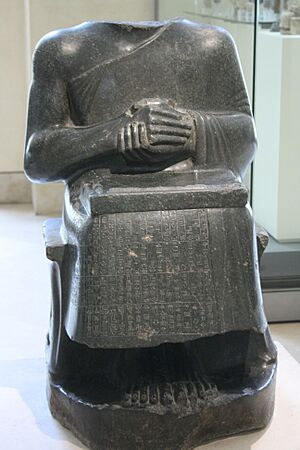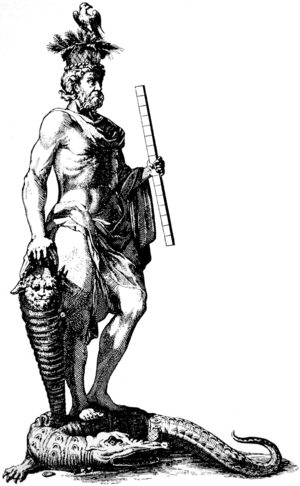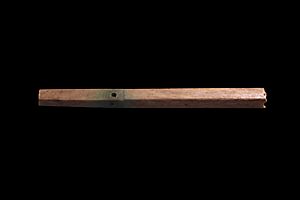Measuring rod facts for kids

A measuring rod is a simple tool used to find out how long things are. It helps people measure lengths and map out areas of different sizes. Most measuring rods are shaped like a circle or a square, but some are flat boards. Many have marks on them to show specific lengths. It's thought that measuring rods were used long before modern tools like tapes or chains were invented.
History of Measuring Rods
Measuring rods have been used for thousands of years by different civilizations around the world. They helped people build amazing structures and organize their lands.
Ancient Sumer: The First Rods
The oldest measuring rod ever found is a bar made of copper. It was discovered in a place called Nippur by a German expert named Eckhard Unger. This ancient bar is from around 2650 BC, which is over 4,600 years ago!
Unger believed this bar was used as a standard for measuring. It helped define the Sumerian cubit, which was about 51.85 centimeters long. A cubit was a common unit of length in ancient times, often based on the length of a forearm.
Ancient India: Ivory Rulers
In ancient India, people used rulers made from ivory. These were found in the Indus Valley Civilization, in what is now Pakistan and parts of Western India. Some of these rulers date back to before 1500 BCE.
One ruler found at a site called Lothal (from 2400 BCE) was marked very precisely. It was divided into tiny units, showing how skilled these ancient people were at measuring.
Ancient East Asia: Many Uses
Measuring rods were also used in China and other parts of East Asia around 2000 BCE. They had different rods for different jobs, like building, making clothes, and measuring land.
Ancient Egypt: Cubit Rods
The ancient Egyptians used cubit-rods made of wood or stone. These rods helped them build huge structures like the Pyramids. Many of these rods have been found in tombs of important officials.
For example, two cubit rods were found in the tomb of Maya, who was a treasurer for the pharaoh Tutankhamun. These rods were about 52.5 centimeters long. They were divided into seven "palms," and each palm was divided into four "fingers." This shows how detailed their measurements were.
Egyptian measuring rods also had marks for another unit called the "Remen," which was about 37 centimeters. This unit was important for building the Pyramids.
Ancient Europe: Wooden Rods
In Europe, measuring rods have been found from the Iron Age and Bronze Age. An oak rod from Denmark was about 135 centimeters long. It was divided into eight parts, which matched an ancient Greek measurement called the "Doric Pous" (a type of foot).
Another hazel rod from a Bronze Age burial mound in Denmark was about 78.5 centimeters long. This length matched the traditional Danish foot. Some experts believe that ancient stone structures in Great Britain were built using a "Megalithic Yard," possibly measured with bone fragments used as rods.
Roman Empire: The Decempeda
The Roman Empire used measuring rods a lot, especially for building their famous roads and forts. They needed accurate measurements for their huge public works.
The Romans used a "Roman foot" that was about 29.6 centimeters long. Their main measuring rod was called a decempeda, which means "ten-footer" in Latin. It was 10 Roman feet long (about 2.96 meters). These rods were usually square and had metal caps on the ends.
The decempeda was a key tool for Roman surveyors, who were called Gromatici. You can often see measuring rods in Roman art, showing surveyors at work.
Middle Ages: The Rod Unit
In the Middle Ages, long bars were used to measure land. These bars often used a unit called a "rod." A rod was equal to 5.5 yards, or about 5 meters. It was also known as a "perch" or a "pole."
This unit was based on the length of the stick used to guide a team of oxen when plowing. The length of the rod and a longer unit called the "chain" (four rods) were standardized in 1607. Even in the mid-1800s, writers like Henry David Thoreau still used the "rod" to describe distances in his books.
Measuring Rods in Culture
Measuring rods appear in many ancient stories, artworks, and religious texts. They often symbolize order, justice, and creation.
In Art and Symbols
- Gudea Statues: Two statues of Gudea of Lagash show him with a tablet on his lap, holding surveying tools, including a measuring rod.
- Shamash and Hammurabi: The sun-god Shamash is shown giving a measuring rod and a coiled rope to new surveyors on an ancient tablet. A similar scene is on top of the famous Code of Hammurabi, a set of ancient laws.
- Greek Goddess Nemesis: The Greek goddess Nemesis, who represented divine justice, is often shown with a measuring rod or a tally stick.
- Serapis: The ancient god Serapis, from Egypt and Greece, is often seen holding a measuring rod.
In Mythology
- Inanna's Descent: In an ancient myth, the goddess Inanna prepares for her journey to the underworld by holding a "lapis-lazuli measuring rod and measuring line."
- Lachesis: In Greek mythology, Lachesis was one of the three Fates. She used her measuring rod to decide how long each person's life would be.
- Varuna and Vishnu: In ancient Indian myths, the god Varuna is said to use the Sun as a measuring rod to create space. The god Vishnu is also described as having "measured the regions of the Earth."
In the Bible
Measuring rods are mentioned several times in the Bible. They often appear in visions or when describing important measurements.
- Ezekiel's Vision: In the book of Ezekiel, a man with a bronze appearance is seen holding a "linen cord and a measuring rod" to measure a city.
- Revelation: In the book of Revelation, a "reed like a measuring rod" is used to measure the temple of God. Later, a "gold measuring rod" is used to measure the walls and gates of a holy city.
Images for kids
See also
- Ancient Egyptian units of measurement
- Ancient Greek units of measurement
- Ancient Mesopotamian units of measurement
- Distance measurement
- Levelling rod
- Rod (unit)
- Rod-and-ring symbol
- Ruler
- Shen ring
- Surveying
- Units of measurement







